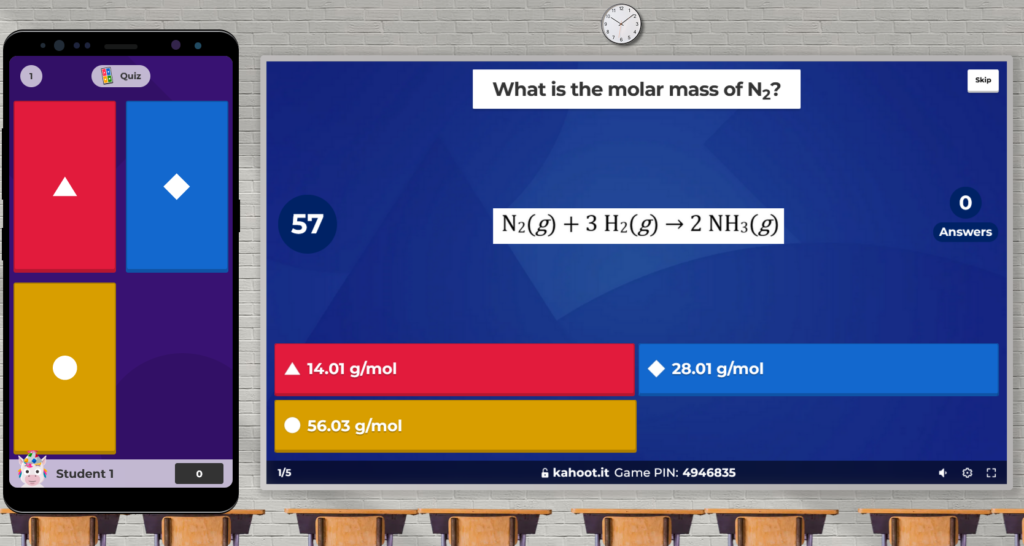What is it?
Kahoot! is a service which allows people to make online quizzes which learners can join from their mobile devices or computers. It’s quite popular in secondary education. You can play a demo game to learn about Kahoot.
It could be used for an in-class pre-quiz or review activity. Students could also make their own as a way to demonstrate their understanding of the material.

What are the benefits?
Student engagement: Since students can choose their own nicknames, the game can be pseudonymous, and students can feel more safe volunteering their answers. Kahoot uses bright colours and cheerful music during the game to attract attention, and there is some mild competition with the points awarded for each question.
Nursing instructors asked students to come up with questions based on an assigned medication, and then used some of those questions in a Kahoot for the class (Bryant et al., 2018). Both parts of the activity (question generation and playing the Kahoot) were well-received by the class.
Immediate feedback: Once time is up for a question, students see the correct answer, as well as the distribution of answers in the class. Instructors can take the opportunity to clarify concepts that seem to be causing the class difficulty.
Library of quizzes: Kahoot users may make their quizzes public, and you may present one of these quizzes. Any premium features will still work, even if you have a free account.
What are the challenges?
Limited free access: With a Basic (free) account, the only question types available are Multiple Choice (up to 4 options) and True/False. Kahoots are also limited to 10 players for higher education accounts, but this limit increases to 40 for K-12 teacher accounts. A paid account has access to more question types, higher player limits, and other premium content.
Limitations on questions: The maximum time limit for a Kahoot question is two minutes, so complicated problems are not suited for this type of quiz (Murciano-Calles, 2020). Conceptual questions are more suitable.
Time limits: Since participants in the quiz earn more points for correct answers that were entered sooner, some students choose to guess, rather than engage with the question. Additionally, some students find the time limits stressful.
Technical problems: As with all online tools, students may be disconnected during the game, or have trouble joining. However, they can join at any time during the game, as the game PIN is always displayed on screen.
Who’s using this?
Information on KPU users pending… if you’ve used this technique and you’re willing to share thoughts about your and your students’ experience, send me an email!
Outside KPU, regular Kahoot quizzes were used in a pair of thermodynamics engineering courses (Chernov et al., 2021). Students in those classes reported increased motivation to study in preparation for the quizzes.
The effect of Kahoot on classroom learning was the subject of a literature review (Wang & Tahir, 2020). Both students and teachers generally report favourable impressions of Kahoot, and a number of challenges were also identified.
Resources
Because Kahoot is an external tool, review the guidelines for acceptable use within KPU. Following these guidelines will ensure that you are protecting your students’ privacy.
References
Bryant, S. G., Correll, J. M., & Clarke, B. M. (2018). Fun with pharmacology: Winning students over with Kahoot! game-based learning. The Journal of Nursing Education, 57(5), 320-320. https://doi.org/10.3928/01484834-20180420-15 KPU Library Permalink: https://go.exlibris.link/DdQlYdYt
Chernov, V., Klas, S., & Furman Shaharabani, Y. (2021). Incorporating Kahoot! in core engineering courses: Student engagement and performance. Journal of Technology and Science Education, 11(2), 486-497. https://doi.org/10.3926/jotse.1269 KPU Library Permalink: https://go.exlibris.link/1mpNsQZy
Murciano-Calles, J. (2020). Use of Kahoot for assessment in chemistry education: A comparative study. Journal of Chemical Education, 97(11), 4209-4213. https://doi.org/10.1021/acs.jchemed.0c00348 KPU Library Permalink: https://go.exlibris.link/VzS61JT8
Wang, A. I., & Tahir, R. (2020). The effect of using Kahoot! for learning – A literature review. Computers and Education, 149, 103818. https://doi.org/10.1016/j.compedu.2020.103818 KPU Library Permalink: https://go.exlibris.link/kMlxlB3y

